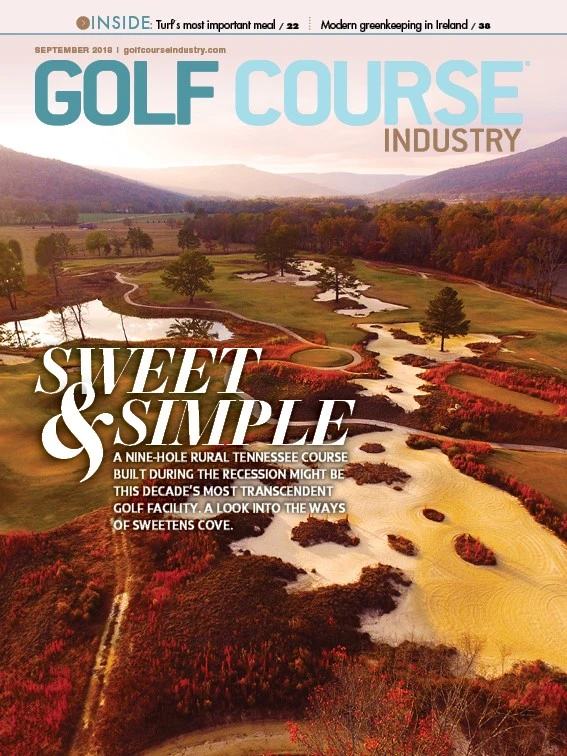Did you see the 42-year-old strutting into a clubhouse wearing shades, a backward hat and collarless shirt?
On a Sunday morning. At an upscale private club. During a major championship.
Bravo to the cameras for catching Tiger Woods’ entrance before the final round of the 100th PGA Championship. OK. The cameras caught everything he did that Sunday, including recovery shots from the Ozarks.
Two days after watching the final round, I visited Sweetens Cove, the rural Tennessee course featured in this month’s cover story to meet with architect/owner/operator Rob Collins and superintendent Brent Roberson. I expected to find no link between Tiger’s PGA Championship appearance and Sweetens Cove, yet on my drive from South Pittsburg to Nashville for the GCBAA Summer Meeting, I became captivated by the welcoming vibe exhibited throughout the imaginative nine-hole course. “If we were anymore laid-back, we’d be dead,” says Collins, who wore a T-shirt with a course logo and shorts to our meeting.
I also didn’t expect to find a link between Tiger’s appearance and the GCBAA gathering until noticing “business casual” listed as the suggested attire for all events, including the annual dinner and auction supporting the GCBAA Foundation and Sticks for Kids. Executive director Justin Apel reiterated the message during the educational sessions.
To me, a 38-year-old wannabe millennial, business casual means a golf shirt and khakis. If we’re outside and its toasty, I’ll wear shorts, unless the task involves walking through thick native areas. I operate best when comfortable. I purchased a blazer a few months after landing at GCI in 2014, but it hasn’t left the closest since I unpacked following GIS 2015. I would rather risk one stranger calling me unprofessional – which has never happened in my presence – then become another writer/editor wearing an awful blazer or a snooty golf dude.
Yes, despite persistent efforts to become more inclusive, golf hasn’t fully ditched the ROWG label. Why? Some organizations and clubs feature lists of rules, which include throwback dress codes, longer than Ron Chernow’s 1,104-page Ulysses S. Grant biography. Think about the last industry gathering you attended. Did you really need that suit to feet and act professional while attending educational sessions and visiting tradeshow booths occupied by peers?
Call me Pro Shop Guy, but wearing a golf shirt with the club or company logo exudes professionalism and pride, and promotes inclusiveness. A club logo is a form of marketing. Logos, especially creative ones, spark conversation about a golf facility. What you wear can help you tell a positive story about where you work. Wearing a blazer or suit doesn’t offer the same opportunity.
The PGA of America, once viewed as a stuffy organization by outsiders, sent two high-ranking officials, then-CEO Pete Bevacqua and chief championship officer Kerry Haigh, to a PGA Championship news conference in logoed shirts. The duo handled themselves brilliantly. For those wondering, Haigh dispersed enormous praise on Bellerive’s Carlos Arraya and team. Arraya handled himself perfectly in numerous media interviews during the tournament. His attire? Golf shirts and hats with the Bellerive logo.
Before donating your suit or blazer to charity, it’s important to concede a few events still require formal attire: job interviews, committee meetings in elegant rooms, tradition-laced banquets, weddings with a bill footed by a baby boomer and funerals (except mine). But as talented Gen X-ers and millennials ascend to corporate management positions, the formality in our lives and appearances will shrink.
Loosening up a bit will make the golf industry even more lovely.

Explore the September 2018 Issue
Check out more from this issue and find your next story to read.
Latest from Golf Course Industry
- ’Twas the Night Before Christmas (on turf)
- Twas the Night Before Christmas (the turf version audio)
- Advanced Turf Solutions and The Aquatrols Company release soil surfactant
- Heritage Golf Group acquires North Carolina courses
- Editor’s notebook: Green Start Academy 2024
- USGA focuses on inclusion, sustainability in 2024
- Greens with Envy 65: Carolina on our mind
- Five Iron Golf expands into Minnesota





